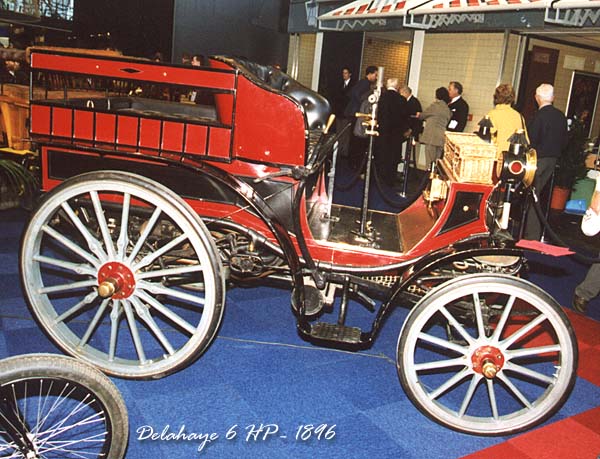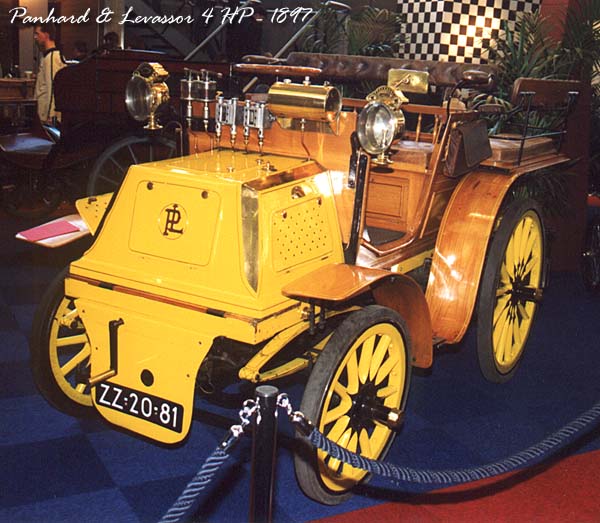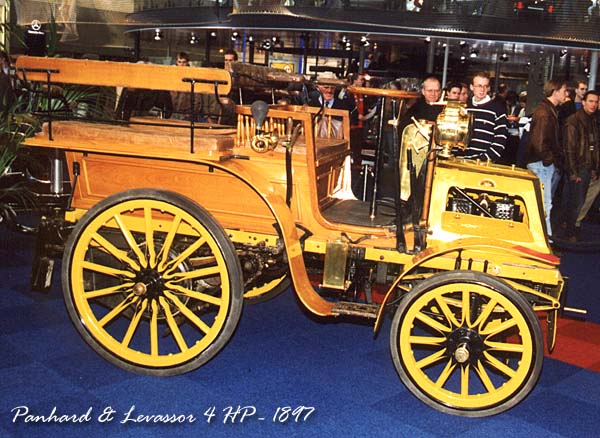

![]()
Centenarian Cars: Delahaye and Panhard & Levassor
 Weiffenbach developed Delahaye into a successful car manufacturer in the
years before the first World War, even selling cars in Germany and Britain. After the
first World War the company lost its inspiration for a while, making well built but
inconspicuous cars until the 1930's. When car sales declined severely due to the
recession, Weiffenbach decided to repolish the Delahaye name by renewing the whole model
range and taking part in races.
Weiffenbach developed Delahaye into a successful car manufacturer in the
years before the first World War, even selling cars in Germany and Britain. After the
first World War the company lost its inspiration for a while, making well built but
inconspicuous cars until the 1930's. When car sales declined severely due to the
recession, Weiffenbach decided to repolish the Delahaye name by renewing the whole model
range and taking part in races.
This started a new era for Delahaye with light, sporty and powerful cars fitted with sleek
and stylish bodywork by well-known coachbuilders like Figoni & Falaschi and Saoutchik.
Best known are the 135 and 145 series. In 1935 Delahaye combined efforts with similar car
manufacturer Delage (actually not more than just a name by then, owned by the Paris Delage
dealer), and the factory continued to thrive until the second World War. In this war
Delahaye switched completely to truck production.
After the second World War Delahaye continued where it stopped before, again taking part
in races and making beautiful but expensive cars. French tax measures led to a decline in
sales again and this time Weiffenbach couldn't turn the trend around. In 1954 Delahaye
merged with arch-rival Hotchkiss and Weiffenbach retired and subsequently died in 1959.
Hotchkiss stopped car production completely and concentrated on commercial vehicles.
 Probably the best known French car
pioneer marque is Panhard & Levassor. This engineering firm started out as Périn et
Pauwels and produced wood and metal bandsaws. René Panhard and Emile Levassor took over
the firm and were looking to expand. On the Paris World Fair in 1889 Gottlieb Daimler
demonstrated his petrol engines by taking people on a boat ride in a boat powered by one
of his engines. Among those people were Mme Sarazin and Emile Levassor. Levassor had been
approached by Edouard Sarazin, a close friend of Daimler, to build the Daimler engines in
France.
Probably the best known French car
pioneer marque is Panhard & Levassor. This engineering firm started out as Périn et
Pauwels and produced wood and metal bandsaws. René Panhard and Emile Levassor took over
the firm and were looking to expand. On the Paris World Fair in 1889 Gottlieb Daimler
demonstrated his petrol engines by taking people on a boat ride in a boat powered by one
of his engines. Among those people were Mme Sarazin and Emile Levassor. Levassor had been
approached by Edouard Sarazin, a close friend of Daimler, to build the Daimler engines in
France.
Levassor was extremely interested and after the death of Edouard Sarazin in 1887 he
continued the project with Sarazin's wife, who had inherited the Daimler patent rights
(and he married her later on). At first Panhard & Levassor only produced the engines
(used by Peugeot for example), but in 1891 the first cars were taken into production.
These were innovative designs with the engine placed transversely instead of lengthwise
and driving the rear wheels by two side chains operated by a countershaft connected to a
two speed gearbox.
Peugeot and Panhard & Levassor, both using the same engines, were in heavy but
friendly competition with each other, the one trying to exceed the other in grueling tests
and competitions. Not until Levassor introduced the "système Panhard", a
lay-out where the engine was in the front of the car driving the rear wheels trough a
drive shaft connected to a gearbox at the engine side and a central chainbelt at the rear
wheels, the Panhard & Levassor cars could get ahead of the Peugeot cars.
 Levassor died in 1896 from the
consequences of the injuries he sustained in the 1895 Paris-Marseilles race. The Panhard
& Levassor company continued to produce Daimler engines, designed by Wilhelm Maybach.
Car and engine production picked up rapidly thanks to reliability and race successes. In
1898 650 people were employed, producing 336 cars.
Levassor died in 1896 from the
consequences of the injuries he sustained in the 1895 Paris-Marseilles race. The Panhard
& Levassor company continued to produce Daimler engines, designed by Wilhelm Maybach.
Car and engine production picked up rapidly thanks to reliability and race successes. In
1898 650 people were employed, producing 336 cars.
That year Panhard & Levassor introduced 4 cylinder in-line engines in their production
cars; they had experimented with Daimler built versions of it since 1896 and after Mors
had taken up production of a V-4 engine in 1897 they didn't want to fall behind. The car
on the picture however has still the trusted 2 cylinder Phénix engine under the bonnet.
Things went rapidly from then on. In 1902 car production rose above 1000 units, 1905 saw
the introduction of the company's first 11 litre 6 cylinder in-line engine, René Panhard
died in 1908 and was succeeded by his son Hippolyte (management remained in the hands of
the Panhard family till the end). After those two turbulent decades Panhard & Levassor
no longer was a pioneering marque but a mainstream car and engine factory. After the
second World War the financial situation of the company lead to a 25% participation by
Citroën. In 1965 Citroën bought the rest of the company after shameful exploitation and
in 1967 the last car bearing the Panhard name left the factory. A shame really...
If you're looking for more veteran cars then Adam Ward's 1000 Mile Trial pages are worth a
visit. It's about the re-enactment of the 1000 Mile Trial of 1900 with a full set of
results and some historical pictures. Also the site contains modern pictures of the cars
that have entered to take part in the re-enactment which includes a picture of Phil Hill
driving the 1896 Paris Marseilles Paris winning Panhard & Levassor.
Finish the tour by clicking the arrows pointing right....
![]()